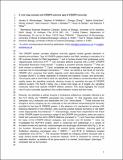Files in this item
An anti-CRISPR viral ring nuclease subverts type III CRISPR immunity
Item metadata
| dc.contributor.author | Athukoralage, Januka Sahan | |
| dc.contributor.author | McMahon, Stephen | |
| dc.contributor.author | Zhang, Changyi | |
| dc.contributor.author | Gruschow, Sabine | |
| dc.contributor.author | Graham, Shirley | |
| dc.contributor.author | Krupovic, Mart | |
| dc.contributor.author | Whitaker, Rachel | |
| dc.contributor.author | Gloster, Tracey | |
| dc.contributor.author | White, Malcolm | |
| dc.date.accessioned | 2020-07-14T23:34:21Z | |
| dc.date.available | 2020-07-14T23:34:21Z | |
| dc.date.issued | 2020-01-23 | |
| dc.identifier | 264190868 | |
| dc.identifier | ce072acd-9b6c-45aa-b384-b78e01cb7f06 | |
| dc.identifier | 000509200100025 | |
| dc.identifier | 000509200100025 | |
| dc.identifier | 85078554373 | |
| dc.identifier.citation | Athukoralage , J S , McMahon , S , Zhang , C , Gruschow , S , Graham , S , Krupovic , M , Whitaker , R , Gloster , T & White , M 2020 , ' An anti-CRISPR viral ring nuclease subverts type III CRISPR immunity ' , Nature , vol. 577 , no. 7791 , pp. 572-575 . https://doi.org/10.1038/s41586-019-1909-5 | en |
| dc.identifier.issn | 0028-0836 | |
| dc.identifier.other | ORCID: /0000-0003-1543-9342/work/68280513 | |
| dc.identifier.other | ORCID: /0000-0002-1666-0180/work/68281771 | |
| dc.identifier.uri | https://hdl.handle.net/10023/20252 | |
| dc.description | This work was supported by grants from the Biotechnology and Biological Sciences Research Council (BB/S000313/1 to M.F.W. and BB/R008035/1 to T.M.G.) and by a NASA Exobiology and Evolutionary Biology grant (NNX14AK23G to R.J.W.). | en |
| dc.description.abstract | The CRISPR system in bacteria and archaea provides adaptive immunity against mobile genetic elements. Type III CRISPR systems detect viral RNA, resulting in the activation of two regions of the Cas10 protein: an HD nuclease domain (which degrades viral DNA)1,2 and a cyclase domain (which synthesizes cyclic oligoadenylates from ATP)3,4,5. Cyclic oligoadenylates in turn activate defence enzymes with a CRISPR-associated Rossmann fold domain6, sculpting a powerful antiviral response7,8,9,10 that can drive viruses to extinction7,8. Cyclic nucleotides are increasingly implicated in host–pathogen interactions11,12,13. Here we identify a new family of viral anti-CRISPR (Acr) enzymes that rapidly degrade cyclic tetra-adenylate (cA4). The viral ring nuclease AcrIII-1 is widely distributed in archaeal and bacterial viruses and in proviruses. The enzyme uses a previously unknown fold to bind cA4 specifically, and a conserved active site to rapidly cleave this signalling molecule, allowing viruses to neutralize the type III CRISPR defence system. The AcrIII-1 family has a broad host range, as it targets cA4 signalling molecules rather than specific CRISPR effector proteins. Our findings highlight the crucial role of cyclic nucleotide signalling in the conflict between viruses and their hosts. | |
| dc.format.extent | 19 | |
| dc.format.extent | 2611992 | |
| dc.language.iso | eng | |
| dc.relation.ispartof | Nature | en |
| dc.subject | System | en |
| dc.subject | Evolutionary | en |
| dc.subject | Mechanism | en |
| dc.subject | Space | en |
| dc.subject | DNA | en |
| dc.subject | QH301 Biology | en |
| dc.subject | QR355 Virology | en |
| dc.subject | DAS | en |
| dc.subject | BDC | en |
| dc.subject | R2C | en |
| dc.subject.lcc | QH301 | en |
| dc.subject.lcc | QR355 | en |
| dc.title | An anti-CRISPR viral ring nuclease subverts type III CRISPR immunity | en |
| dc.type | Journal article | en |
| dc.contributor.sponsor | BBSRC | en |
| dc.contributor.sponsor | BBSRC | en |
| dc.contributor.institution | University of St Andrews. School of Biology | en |
| dc.contributor.institution | University of St Andrews. Biomedical Sciences Research Complex | en |
| dc.identifier.doi | https://doi.org/10.1038/s41586-019-1909-5 | |
| dc.description.status | Peer reviewed | en |
| dc.date.embargoedUntil | 2020-07-15 | |
| dc.identifier.grantnumber | BB/S000313/1 | en |
| dc.identifier.grantnumber | BB/R008035/1 | en |
This item appears in the following Collection(s)
Items in the St Andrews Research Repository are protected by copyright, with all rights reserved, unless otherwise indicated.

